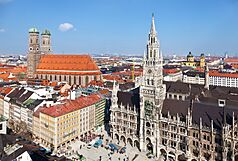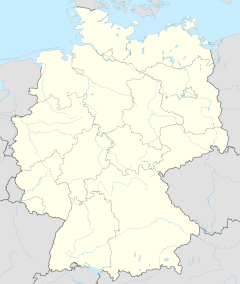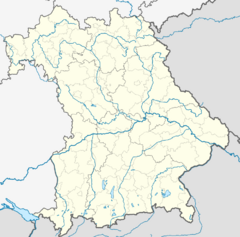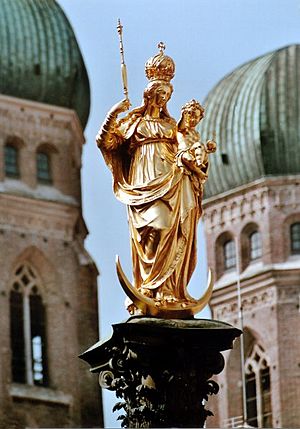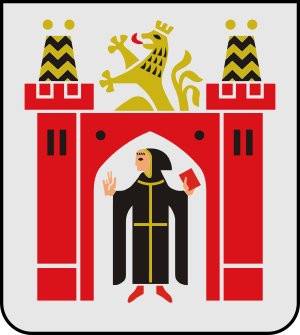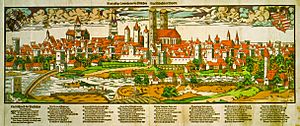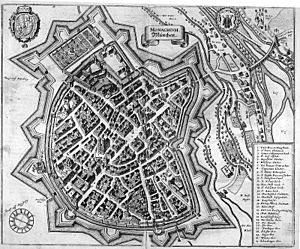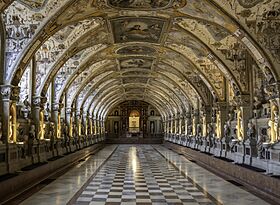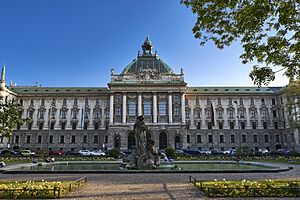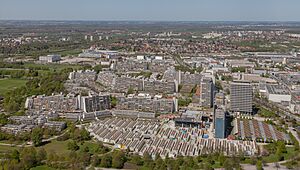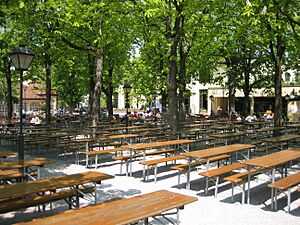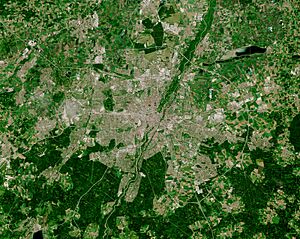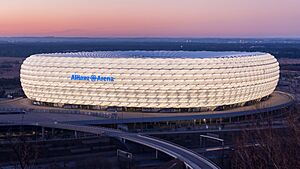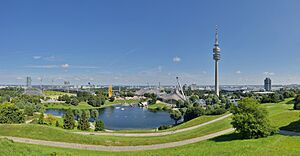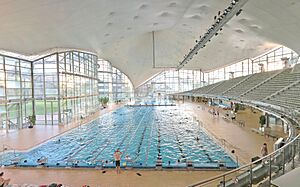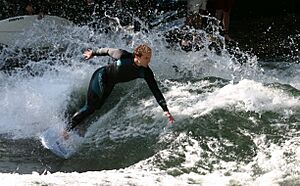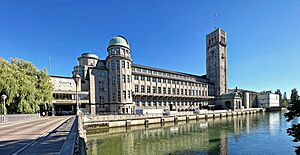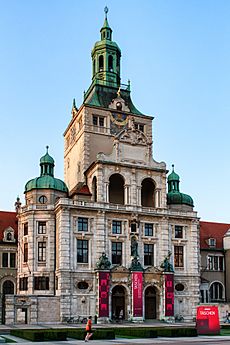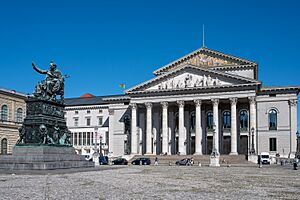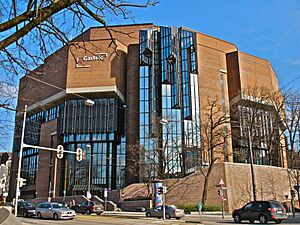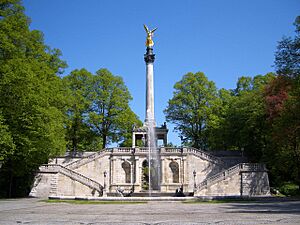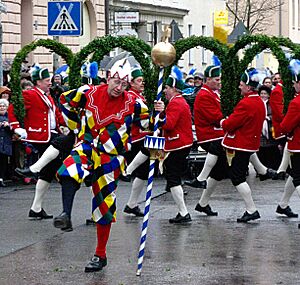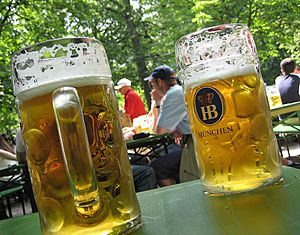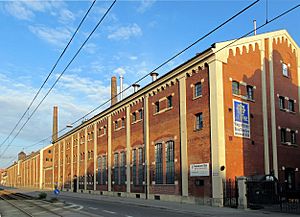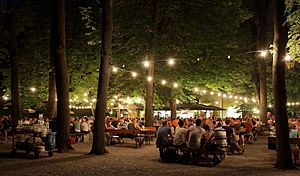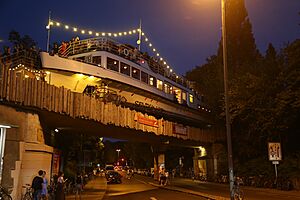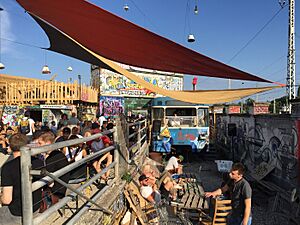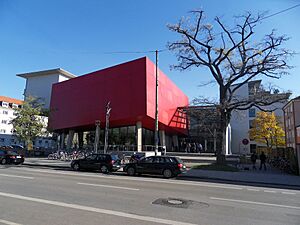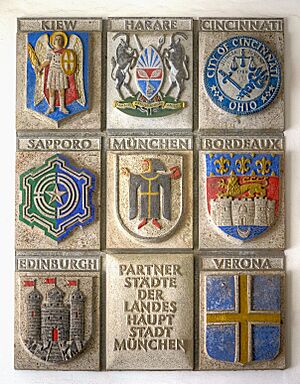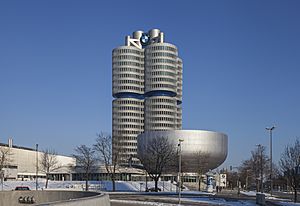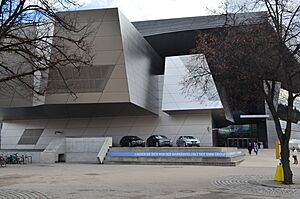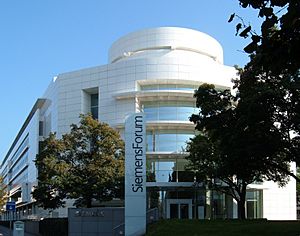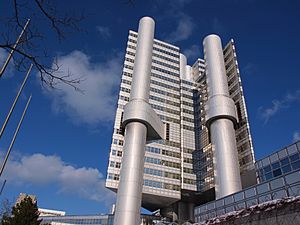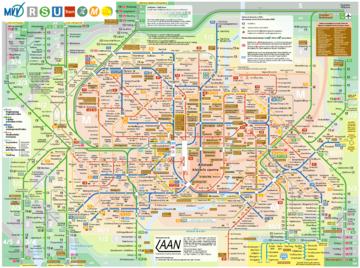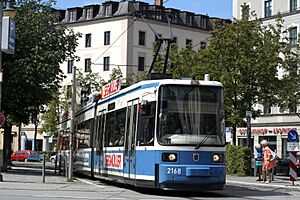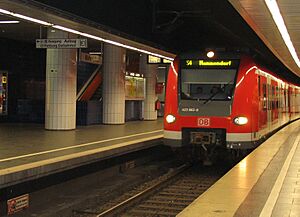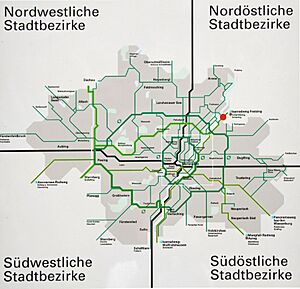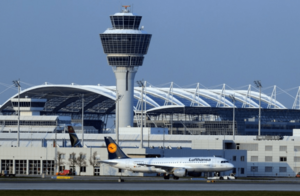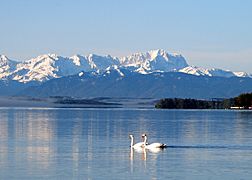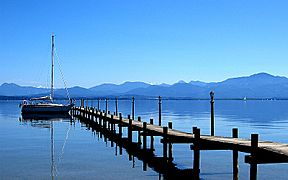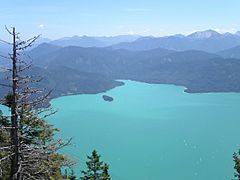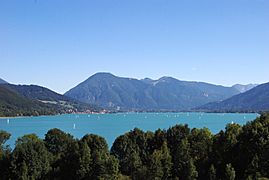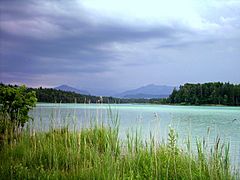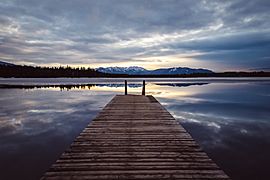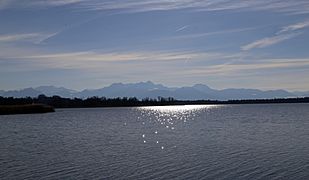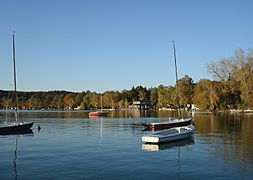Munich facts for kids
Quick facts for kids
Munich
|
|||
|---|---|---|---|
|
Marienplatz with Neues Rathaus and Frauenkirche in the background
Nymphenburg Palace
Munich Residenz
BMW Welt
Ludwigstraße
Feldherrnhalle
|
|||
|
|||
| Country | Germany | ||
| State | Bavaria | ||
| Admin. region | Upper Bavaria | ||
| District | Urban district | ||
| First mentioned | 1158 | ||
| Subdivisions |
25 boroughs
Altstadt-Lehel
Ludwigsvorstadt-Isarvorstadt Maxvorstadt Schwabing-West Au-Haidhausen Sendling Sendling-Westpark Schwanthalerhöhe Neuhausen-Nymphenburg Moosach Milbertshofen-Am Hart Schwabing-Freimann Bogenhausen Berg am Laim Trudering-Riem Ramersdorf-Perlach Obergiesing Untergiesing-Harlaching Thalkirchen-Obersendling-Forstenried-Fürstenried-Solln Hadern Pasing-Obermenzing Aubing-Lochhausen-Langwied Allach-Untermenzing Feldmoching-Hasenbergl Laim |
||
| Area | |||
| • City | 310.71 km2 (119.97 sq mi) | ||
| Elevation | 520 m (1,710 ft) | ||
| Population
(2022-12-31)
|
|||
| • City | 1,512,491 | ||
| • Density | 4,867.85/km2 (12,607.68/sq mi) | ||
| • Urban | 2,606,021 | ||
| • Metro | 5,991,144 | ||
| Time zone | UTC+01:00 (CET) | ||
| • Summer (DST) | UTC+02:00 (CEST) | ||
| Postal codes |
80331–81929
|
||
| Dialling codes | 089 | ||
| Vehicle registration | M, MUC | ||
| Website | stadt.muenchen.de | ||
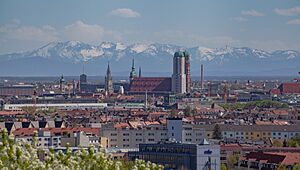
Munich (pronounced MEW-nik) is the capital city of Bavaria, a state in Germany. It is the third-largest city in Germany by population, after Berlin and Hamburg. This makes Munich the biggest German city that is not its own state. It is also one of the largest cities in the European Union. The area around Munich, including its suburbs, is home to about 6.2 million people.
Munich is located on the Isar river, just north of the Alps mountains. It is a very crowded city, with many people living close together. The city was first mentioned in history in the year 1158.
Munich played an important role in history. It strongly resisted the Reformation, a big religious change in Europe. During the Thirty Years' War, the city was occupied by Swedish troops but was not destroyed. In 1806, when Bavaria became a kingdom, Munich grew into a major European center for arts, architecture, culture, and science.
In the 1920s, Munich became a hub for different political groups, including the Nazi Party. After the Nazis took power, they called Munich their "Capital of the Movement." The city was heavily bombed during World War II. However, most of its old buildings have been rebuilt. After the war, Munich saw a huge increase in people and economic growth. The city also hosted the 1972 Summer Olympics.
Today, Munich is a global leader in science, technology, finance, and tourism. People in Munich enjoy a very high standard of living. It is often ranked as one of the best cities to live in worldwide. Munich is also known for being one of the most expensive cities in Germany.
Munich has a diverse population, with many residents from other countries. The city's economy is strong, focusing on high tech, cars, and services. It is also strong in IT, biotechnology, and electronics. Many big international companies, like BMW, Siemens, Allianz SE, and Munich Re, have their main offices here. Munich is also home to two major universities and many science centers. The city's beautiful buildings, cultural events, sports, and the famous annual Oktoberfest attract many tourists.
Contents
- Munich's History: A Journey Through Time
- Munich's Geography and Climate
- Munich's People
- Munich's Architecture: Buildings and Landmarks
- Munich's Parks and Green Spaces
- Sports in Munich
- Munich's Culture and Arts
- Education and Research in Munich
- Munich's International Connections
- Munich's Economy
- Quality of Life in Munich
- Transportation in Munich
- Around Munich: Lakes and Nearby Towns
- Famous People from Munich
- See also
Munich's History: A Journey Through Time
How Munich Got Its Name
Munich began as a small settlement of friars (monks) in the 8th century. Its name, München, comes from the Old High German word Muniche, which means "to the monks."
Early Settlements and Roman Times
The Isar river was an important trade route long ago. During the Bronze Age, Munich was a big port for rafts. Evidence of settlements from this time, up to 4,000 years old, has been found. There are also signs of Celtic settlements from the Iron Age in areas like Ramersdorf-Perlach.
The ancient Roman road, Via Julia, crossed the Isar river south of Munich. Roman settlements have also been found northeast of the city.
The Start of the Medieval Town
The first bridges over the Isar river were in the Munich area. In 1158, Henry the Lion, the Duke of Saxony and Bavaria, founded Munich. He did this to control the important salt trade. He built a new bridge, a customs house, and a coin market. This new bridge was likely where the Museuminsel is today.
There was a disagreement over this with the Bishop of Freising. But on June 14, 1158, the conflict was settled in Duke Henry's favor. This date is now considered the official founding day of Munich. However, old pottery found in 2012 shows that people lived in Munich even before 1158. The old St. Peter's Church also seems to be older than the city's official founding.
In 1175, Munich became a city and was given walls for protection. In 1180, the Wittelsbach family became the rulers of Bavaria. Munich was first given to the Bishop of Freising, but then to the Wittelsbachs in 1240. In 1255, Munich became the main city of Upper Bavaria.
Duke Louis IV, who was from Munich, became the German king in 1314 and Holy Roman Emperor in 1328. He helped the city by giving it a monopoly on salt, which brought in more money.
In 1327, a large fire destroyed about a third of the town. In 1349, the Black Death (a terrible disease) affected Munich and Bavaria.
Munich grew because it was built on a gravel bed, where the Isar river split into many smaller streams. These streams powered mills and industries. In the 15th century, Munich saw a rebirth of Gothic art. The Old Town Hall was made bigger, and the Frauenkirche, a large Gothic church, was built in just 20 years, starting in 1468.
Munich: Capital of Bavaria
In 1506, Bavaria was reunited, and Munich became its capital. The arts and politics were greatly influenced by the royal court. The Renaissance style came to Munich. Duke Albrecht V built the Antiquarium in 1568 to hold his collection of Greek and Roman art in the Munich Residenz. He also brought famous musicians, like Orlando di Lasso, to Munich, making it a center for music.
Duke William V continued to make Munich important. He built the Jesuit Michaelskirche and the Hofbräuhaus in 1589, which became a model for other beer halls. After World War II, many of these historic buildings were rebuilt to look exactly as they did before the war.
In 1609, the Catholic League was founded in Munich. During the Thirty Years' War, Munich became an important city for the electors (rulers who chose the Holy Roman Emperor). However, the city was occupied by King Gustavus Adolphus of Sweden in 1632. The bubonic plague also hit Munich hard in 1634 and 1635.
Munich became a center of Baroque art and life under the Bavarian electors. But it was also occupied by the House of Habsburg in 1704 and 1742. In 1777, Karl Theodor became the new duke. He was not very popular in Munich. In the 1790s, Munich's city walls were torn down, and people started building new houses outside the old city limits.
After making an alliance with Napoleon's France, Munich became the capital of the new Kingdom of Bavaria in 1806. The king, Maximillian IV Joseph, dissolved monasteries and sold church lands to raise money. He also gave the brewing monopoly to Munich's richest brewers, who paid high taxes on their beer.
In October 1810, a beer festival was held to celebrate the wedding of the crown prince. This festival grew into Munich's annual Oktoberfest. Beer became a very important part of life in Munich, especially for working-class people. It was even seen as a "liquid bread" and important for public health.
In the 19th century, Munich's old city walls were mostly removed as the city grew. The first railway station was built in 1839. King Ludwig I (who became king in 1825) ordered famous architects like Leo von Klenze to design many public museums in a neoclassical style. These grand building projects earned Munich the nicknames "Isar-Athen" and "Monaco di Bavaria."
When Ludwig II became king in 1864, he spent more time on his fairytale castles in the countryside. He tried to bring the composer Richard Wagner to Munich, but his plans for an opera house were rejected. Still, Ludwig II's projects helped Munich's craft and construction industries. In 1876, Munich hosted the first German Art and Industry Exhibition.
Around 1900, Munich became a center for the Jugendstil movement, which combined art, design, and architecture. Famous Jugendstil artists from Munich include Hans Eduard von Berlepsch-Valendas and Richard Riemerschmid. In 1911, the expressionist art group Der Blaue Reiter was formed in Munich.
From World War I to World War II
During World War I, life in Munich became very hard due to food and fuel shortages. In 1916, the 'Bayerische Motoren Werke' (BMW) started making aircraft engines in Munich.
After World War I, Munich saw a lot of political unrest. In 1918, the ruling Wittelsbach family had to leave, and a short-lived Bavarian Soviet Republic was declared. Adolf Hitler later described his political beginnings in Munich during this time. In 1919, Bavaria Film was founded, offering an alternative to Germany's largest film studio.
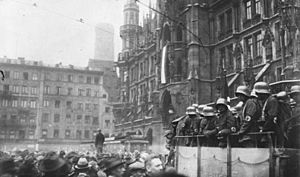
In 1923, Adolf Hitler and his supporters tried to overthrow the government in what was called the Beer Hall Putsch. The attempt failed, and Hitler was arrested.
Munich became important to the Nazis again when they took power in 1933. They built their first concentration camp at Dachau, about 16 km (10 miles) northwest of the city. Munich was called the Hauptstadt der Bewegung ("Capital of the Movement") by the Nazis. Many Nazi offices and buildings were located in Munich. The Haus der Kunst (House of German Art) was the first building Hitler ordered to be built.
In 1938, the Munich Agreement was signed in the city. This agreement allowed Nazi Germany to take over a part of Czechoslovakia, hoping to prevent a war.
On November 8, 1939, Georg Elser tried to assassinate Adolf Hitler in Munich by planting a bomb, but Hitler left minutes before it exploded. By mid-1942, most Jewish people living in Munich had been forced to leave.
During the war, Munich had many forced labor camps, including subcamps of the Dachau concentration camp.
Munich was also the base of the White Rose, a student resistance movement. This group spread leaflets against Hitler. Its main members, including Sophie Scholl and her brother Hans Scholl, were arrested and executed after distributing leaflets at Munich University.
The city was heavily damaged by 71 air raids during World War II. US troops liberated Munich on April 30, 1945.
Munich After the War
After World War II, Munich was completely rebuilt following a careful plan that kept its old street layout. In 1957, Munich's population grew to over one million. The city became very important again for the German economy, politics, and culture, earning it the nickname Heimliche Hauptstadt ("secret capital").
Munich hosted the 1972 Summer Olympics. To prepare, the city built the U-Bahn (subway) and the S-Bahn (commuter railway). A large pedestrian zone was also created in the city center.
During the 1972 Olympics, a tragic event called the Munich massacre occurred. Palestinian terrorists took members of the Israeli Olympic team hostage, and 11 athletes were killed. The deadliest attack in Germany's history, the Oktoberfest bombing, also happened in Munich and was blamed on neo-Nazis.
In the 1980s and 1990s, Munich became a leading high-tech region in Germany. Its economy grew with many jobs, low unemployment, and high incomes. Munich is home to the famous Nockherberg Strong Beer Festival, which has been televised since the 1980s.
In 2007, the Isar river in Munich was restored to a more natural state, which helps with flood protection. About 20 percent of buildings in Munich now have "green roofs" (roofs covered with plants). Munich has also been a host city for major football tournaments like UEFA Euro 2020 and is planned for UEFA Euro 2024.
Munich's Geography and Climate
Munich's Landscape
Munich is located on a high plain in Upper Bavaria, about 50 km (31 miles) north of the Alps. The city is about 520 meters (1,706 feet) above sea level. The main rivers are the Isar and the Würm. Munich is in the northern part of the Alpine Foreland. This area has fertile land and some hills. In some places, groundwater can come to the surface, creating marshes.
Munich's Weather
Munich has an oceanic climate, with warm to hot summers and cold winters. The warmest month is usually July, and the coldest is January.
Being close to the Alps means Munich gets more rain and snow than many other parts of Germany. Showers and thunderstorms are common in late spring and summer. The Alps also bring a warm downhill wind called the föhn wind, which can quickly raise temperatures, even in winter.
Munich's weather can change a lot because it's in the center of Europe. Summers are usually pleasant, with daytime temperatures around 25 °C (77 °F). Winters are generally cold and cloudy, with some snow. Very cold temperatures can occur when cold air sinks from the nearby Alps.
The highest temperature ever recorded in Munich was 37.5 °C (99.5 °F) in July 1983. The lowest was -31.6 °C (-24.9 °F) in February 1929.
How Climate Change Affects Munich
Like many places, Munich is experiencing global warming, with average yearly temperatures rising. The city council expects more heat extremes, more hot days and nights, changes in rain patterns, and more heavy local rain. Munich is working on plans to adapt to these changes and protect its environment.
Munich's People
Munich's population has grown a lot over the centuries. In 1700, there were only 24,000 people. By 1901, it was 500,000, and by 1957, it reached over 1 million. In 2022, Munich's population was 1.5 million.
People from Other Countries
Munich is a very diverse city. In December 2023, about 477,855 foreign nationals lived in Munich. Many of them are from other European Union countries. The largest groups of foreign nationals are from Turkey, Croatia, Italy, and Greece. Some Croats even call Munich their "second capital."
Religion in Munich
A large number of Munich residents (about 45%) do not belong to any religious group. This group is growing the fastest. The number of people in Catholic and Protestant churches has been declining. In 2017, about 31.8% of people were Catholic, 11.4% Protestant, and 3.6% Orthodox. About 8.6% of Munich's population was Muslim in 2013.
Munich is also home to the largest Uyghur population in Germany. Many Uyghurs have sought safety in Munich, and the World Uyghur Congress is based there.
Munich's Architecture: Buildings and Landmarks
Old Town Buildings
The heart of Munich's old town is Marienplatz. Here you'll find the Old Town Hall and the New Town Hall. The New Town Hall's tower has a famous Glockenspiel (a musical clock). The Peterskirche is the oldest church in the city center. Nearby, the Gothic Heiliggeistkirche was changed to a Baroque style and overlooks the Viktualienmarkt (a popular market).
Three old gates from the medieval city walls still stand: the Isartor, the Sendlinger Tor, and the Karlstor. The Karlstor leads to Stachus, a square dominated by the Justizpalast (Palace of Justice).
The Frauenkirche is Munich's main Catholic cathedral. The nearby Michaelskirche is the largest renaissance church north of the Alps. The Theatinerkirche is a beautiful Baroque church that influenced architecture in southern Germany. Its dome stands out at Odeonsplatz.
Palaces and Castles
Nymphenburg Palace (Schloss Nymphenburg), started in 1664, is a large museum that you can visit.
The smaller Fürstenried Palace (Schloss Fürstenried), built between 1715 and 1717, is used for conferences by the local Catholic church.
Blutenburg Castle (Schloss Blutenburg) opened as a children's library in 2024. You can also visit its late-Gothic church.
The huge Munich Residenz complex, on the edge of the Old Town, is one of Europe's most important museums of interior design. Inside is the amazing Cuvilliés Theatre and next door is the National Theatre Munich. Many old mansions, like the Palais Porcia and Palais Holnstein, are also near the Residenz. The Alter Hof was the first home of the Wittelsbach family.
Modern Buildings
Munich has some interesting modern buildings. Several tall buildings are grouped together at the northern edge of the city, creating a skyline. These include the HVB Tower, the Arabella High-Rise Building, the Highlight Towers, Uptown Munich, and the BMW Headquarters near the Olympic Park. More tall buildings are in the Werksviertel area.
City Development
Munich has a long-term plan for building homes called LaSie. This plan helps the city deal with its housing needs. It focuses on building more homes in existing areas, turning industrial areas into living spaces, and creating new housing developments on the city's outskirts.
Munich's Parks and Green Spaces

The Englischer Garten is a famous park designed between 1789 and 1807. It was one of the first public gardens in Europe. The parks of Nymphenburg Palace and the Botanischer Garten München-Nymphenburg were also designed in a similar style.
Other large green areas in Munich include the Olympiapark, the Westpark, and the Ostpark. The city's oldest park is the Hofgarten, which is near the Residenz and dates back to the 16th century. The Hirschgarten, a former royal hunting ground, is now home to the city's largest beer garden.
Sports in Munich
Football (Soccer)
Munich is home to several professional football teams. The most famous is FC Bayern Munich, which is one of the most successful clubs in Germany and well-known around the world. Other notable clubs include 1860 Munich. Munich also hosted matches during the 2006 FIFA World Cup.
Other Sports
Munich has a professional basketball team, FC Bayern Munich Basketball. The city also hosted the final stages of the FIBA EuroBasket 1993, where the German national team won gold.
The city's ice hockey team is EHC Red Bull München. They have won several DEL Championships.
Olympics and Running Events
Munich hosted the 1972 Summer Olympics. The Munich massacre happened in the Olympic Village during these games. Munich also tried to host the 2018 Winter Olympic Games but was not chosen.
Regular running events in Munich include the Munich Marathon in October and the Stadtlauf in June.
Swimming and Surfing
Munich has many public swimming pools, both indoors and outdoors. Popular indoor pools include the Olympia Schwimmhalle from the 1972 Olympics and the historic Müllersches Volksbad. You can also swim in artificial lakes like the Riemer See.
River surfing is a popular sport in Munich. The Eisbach river has a famous standing wave where experienced surfers ride. The annual Munich Surf Open is held there.
Munich's Culture and Arts
Language Spoken in Munich
German is the main language spoken in Munich. While there are many German dialects, "Standard German" is taught in schools and understood by most people. The Bavarian dialect is also spoken in the region.
Museums in Munich
The Munich City Museum shows works like the Gothic Morris dancers.
In 1903, the Deutsches Museum was founded. It is one of the oldest and largest science and technology museums in the world. It has three locations, and the main one in central Munich continues to expand its exhibits.
Munich has many important art galleries, mostly in the Kunstareal (Art Area). The Lenbachhaus displays works by the Der Blaue Reiter (The Blue Rider) movement, a group of modernist artists from Munich. The Neue Pinakothek and the Pinakothek der Moderne show a mix of classic and modern art.
The Alte Pinakothek has paintings by European masters from the 14th to 18th centuries, including famous works by Albrecht Dürer and Raphael. You can see a large collection of Greek and Roman art in the Glyptothek and the Staatliche Antikensammlungen. The Staatliche Sammlung für Ägyptische Kunst has Egyptian art.
Other interesting museums include the Museum Five Continents, which has artifacts from outside Europe, and the Bavarian National Museum, which shows regional art and history. The Schackgalerie has important German paintings from the 19th century.
Just outside the city is the memorial museum of the former Dachau concentration camp.
Music in Munich
Munich is a major international music center. Many famous composers, like Wolfgang Amadeus Mozart, Richard Wagner, and Richard Strauss, have worked here. Some well-known classical pieces, like Richard Strauss's Also sprach Zarathustra and Carl Orff's Carmina Burana, were created in or near Munich.
Opera and Orchestras
Richard Wagner premiered his opera Die Meistersinger von Nürnberg in Munich. The National Theatre Munich is now home to the Bavarian State Opera and the Bavarian State Orchestra. The Cuvilliés Theatre is also a beautiful opera house.
The Munich Philharmonic Orchestra performs at the modern Gasteig center. The Bavarian Radio Symphony Orchestra is another important orchestra in Munich. Many famous conductors have led these orchestras.
Pop and Electronic Music
Munich was a center for Krautrock music in southern Germany, with bands like Amon Düül II and Queen recording albums here. Munich also played a big part in electronic music. Giorgio Moroder, who helped create synth disco and electronic dance music, lived and worked in the city. Donna Summer, a famous disco singer, also lived here. In the late 1990s, Electroclash music was developed in Munich.
Other notable musicians from Munich include Lou Bega and Münchener Freiheit. Munich hosted several Love Parades and Mayday Party rave events in the 1990s.
Theatre in Munich
The Munich Kammerspiele is one of Germany's most important theaters. Many famous writers have had their plays performed in Munich, including Henrik Ibsen and Bertolt Brecht.
Schwabing: A Creative Hub
At the start of the 20th century, Schwabing was a major cultural center. Many German and international artists and writers lived there.
Vladimir Lenin wrote What Is to Be Done? while living in Schwabing. The area had many "Artist's Cafés" like Café Stefanie and Kabarett Simpl. The Simpl was named after Munich's satirical magazine Simplicissimus, which was known for its funny and sharp attacks on German society.
Famous Writers and Artists
Many famous writers lived in Munich, especially during the late Kingdom of Bavaria. These include Thomas Mann, Heinrich Mann, and Rainer Maria Rilke.
Karl Valentin, a comedian, is still a beloved cultural icon of Munich. He wrote and performed many funny sketches and short films. The cabaret scene in Munich was very active in the 1920s but was stopped when the Nazis took power.
After World War II, Munich again became a center for German literature. Writers like Erich Kästner and Michael Ende made the city their home.
Munich has also been home to many great artists from the Gothic to the Baroque eras, such as Erasmus Grasser and Ignaz Günther. Later, painters like Carl Rottmann and Carl Spitzweg also lived here.
Cinema in Munich
Munich was a key place for the New German Cinema movement, with directors like Rainer Werner Fassbinder and Werner Herzog. Many of Fassbinder's films were set in Munich.
The Bavaria Film Studios were founded in 1919 and became one of Europe's largest film studios. Famous directors like Alfred Hitchcock, Stanley Kubrick, and Wolfgang Petersen made films there. Some well-known movies produced at the studios include The Great Escape (1963) and The Neverending Story (1984). Munich remains an important center for the German film industry.
Festivals in Munich
Coopers' Dance
The Coopers' Dance (Schäfflertanz) is a traditional dance of barrel makers that started in Munich. It is usually performed every seven years.
Starkbierfest
This "strong beer" festival is held for three weeks in March and April during Lent. The strong beer was first made by monks in 1651. It became a public festival in 1751 and is now Munich's second-largest beer festival.
Frühlingsfest
This spring festival is held for two weeks at the Theresienwiese from late April to early May. New local spring beers are served.
Auer Dult
The Auer Dult is a regular event that combines a market with a German-style folk festival. It has up to 300 stalls selling handmade crafts, household goods, and local foods.
Kocherlball
Munich's Kocherlball (Cooks' Ball) is an annual event that celebrates all servants, from kitchen staff to cooks. This tradition began in the 19th century.
Tollwood Festival
The Tollwood Festival is usually held in July and December at Olympia Park. It features arts, live music, and booths selling handmade crafts and organic food.
Oktoberfest
The Oktoberfest is the world's largest beer festival, held at the Theresienwiese. It runs for 16–18 days from late September to early October. Over six million visitors come each year. Beer is served from Munich's six main breweries.
Christkindlmarkt
The Munich Christkindlmarkt (Christmas market) began to develop in the 14th century.
Food and Drink in Munich
Munich's food is part of the wider Bavarian cuisine. The famous Munich Weisswurst ("white sausage") was invented here in 1857. It is a Munich specialty, traditionally served in pubs before noon with sweet mustard and fresh pretzels.
Munich has many restaurants that have received Michelin Guide stars, showing their high quality.
Beers and Breweries
Munich is famous for its breweries and Weissbier (wheat beer). Helles, a pale lager, is the most popular beer today. It has largely replaced Munich's traditional dark beer, Dunkel. Starkbier is the strongest Munich beer.
Wirtshäuser are traditional Bavarian pubs, many with outdoor seating. Biergärten (beer gardens) are a very popular part of Munich's culture. They are places where people from all walks of life can gather. Some beer gardens have thousands of seats, like those in the Englischer Garten and at the Hirschgarten.
Munich has six main breweries: Augustiner-Bräu, Hacker-Pschorr Brewery, Hofbräuhaus, Löwenbräu, Paulaner, and Spaten-Franziskaner-Bräu. Smaller breweries are also becoming more common.
Nightlife in Munich
Munich's nightlife is mostly found in areas like Ludwigsvorstadt-Isarvorstadt, Maxvorstadt, and Au-Haidhausen. There's also the "Feierbanane" (party banana) area, a street with many clubs, bars, and restaurants.
In the 1960s and 1970s, Schwabing was a famous nightlife center with clubs like Blow Up and Yellow Submarine. Munich was even called "New York's big disco sister." However, Schwabing has become more expensive, and much of its nightlife has moved.
The Rosa Viertel (pink quarter) in the Glockenbachviertel became a center for the gay community in the 1980s. Freddie Mercury, the lead singer of Queen, lived in Munich and filmed a music video in a club there.
In the mid-1990s, the Kunstpark Ost and later Kultfabrik became a huge party area with over 30 clubs. This area was popular with young people and tourists. Munich's nightlife changes quickly, with new places opening and closing often.
Munich has more music venues than any other German city, with over 100 nightclubs and thousands of bars and restaurants. Some popular techno clubs include Blitz Club and Harry Klein. Other popular clubs include Call me Drella and the party ship Alte Utting.
Education and Research in Munich
Colleges and Universities
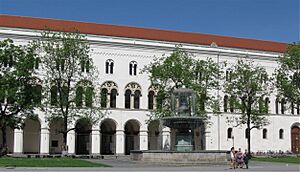

Munich is a leading place for science and research. Many Nobel Prize winners have come from its universities, from Wilhelm Röntgen in 1901 to Theodor W. Hänsch in 2005.
The Ludwig Maximilian University (LMU) and the Technical University of Munich (TUM) are two of Germany's top universities.
Other important schools include:
- Akademie der Bildenden Künste München
- Bundeswehr University Munich
- Deutsche Journalistenschule
- Hochschule für Musik und Theater München (Music and Theatre)
- Munich Business School (MBS)
- Munich School of Philosophy
- Munich University of Applied Sciences (HM)
- University of Television and Film Munich
Schools for Younger Students
Munich has several notable high schools (Gymnasien), such as the Maria-Theresia-Gymnasium and the Wilhelmsgymnasium. There are also several international schools, including the Lycée Jean Renoir and the Munich International School.
Scientific Research Centers
The Max Planck Society, a major research organization, has its main office in Munich. The Fraunhofer Society, which focuses on applied research, also has its headquarters here.
Other research institutes include:
- European Southern Observatory
- Helmholtz Zentrum München
- German Aerospace Center (GSOC)
Munich's International Connections
Sister Cities
Munich has "sister city" relationships with several cities around the world. These connections help promote cultural exchange and friendship.
- Edinburgh, Scotland, UK (since 1954)
- Verona, Italy (since 1960)
- Bordeaux, France (since 1964)
- Sapporo, Japan (since 1972)
- Cincinnati, United States (since 1989)
- Kyiv, Ukraine (since 1989)
- Harare, Zimbabwe (since 1996)
- Beersheba, Israel (since 2021)
Munich's Economy
Munich has one of the strongest economies in Germany. It has a very low unemployment rate compared to other large German cities. Munich is also a very attractive place for businesses. It is the economic center of southern Germany.
Munich is a major financial center and a global city. Many large companies have their headquarters here. This includes more companies listed on the DAX (Germany's main stock market index) than any other German city. Many foreign companies, like McDonald's and Microsoft, also have their German or European headquarters in Munich. A well-known company started in Munich is Flixbus.
Major Industries
Munich is home to the main offices of:
- Siemens AG (electronics)
- BMW (cars)
- MAN AG (trucks and engineering)
- MTU Aero Engines (aircraft engines)
- Linde (gases)
- Rohde & Schwarz (electronics)
Munich is also a center for biotechnology, software, and other service industries. It is home to other big companies like Krauss-Maffei (injection molding machines) and Arri (cameras and lighting). Infineon Technologies (semiconductors) and Osram (lighting) are also based nearby.
Finance and Insurance
Munich is an important financial center, second only to Frankfurt. It is home to major banks like HypoVereinsbank and Bayerische Landesbank. Munich is even more important for insurance companies, with headquarters for Allianz and Munich Re.
Media and Film
Munich is the largest publishing city in Europe. It is home to the Süddeutsche Zeitung, one of Germany's biggest daily newspapers. The main offices for Germany's largest public broadcasting network, ARD, are in Munich. The German branch of Random House, the world's largest publishing house, is also here.
The Bavaria Film Studios are located in the suburb of Grünwald. They are one of Europe's largest film production studios.
Quality of Life in Munich
Most people living in Munich enjoy a high quality of life. Munich is often ranked among the top cities in the world for its quality of life. It has a strong economy, especially in technology and publishing.
Environmental pollution is low in Munich. However, the city council is working to reduce small particles in the air, especially along major roads. Environmental groups like Greenpeace have pushed for stricter rules on pollution. Because of the high quality of life and strong economy, many people have moved to Munich. Its population grew by over 20% in just 10 years, reaching 1.5 million by June 2015.
Transportation in Munich
Munich has a great public transport system. It includes an underground metro (U-Bahn), trams, buses, and high-speed trains. In 2015, public transport was used for 38% of trips in Munich.
Munich is a major transport hub. It has the second-largest airport in Germany. The Berlin–Munich high-speed railway connects Munich to Berlin in about 4 hours. Flixmobility, a company that offers intercity bus services, is also based in Munich.
The Neue Messe München (Messe München International) hosts the Transport Logistic trade fair every two years.
Public Transport System
Munich and its suburbs have a full public transport network. This includes the Munich U-Bahn (subway), the Munich S-Bahn (commuter rail), trams, and buses. The system is managed by the Munich Transport and Tariff Association. The Munich tramway is the oldest public transport system in the city, operating since 1876.
The subway and tram lines make it easy to walk around the city center. Many streets in the center are for pedestrians and bikes only. This makes Munich a great city to explore on foot or by bike.
Cycling in Munich
Cycling is very popular in Munich and is seen as a good way to get around. The city has a growing number of bicycle lanes that are used all year. You can find bike paths next to most sidewalks and streets. A modern bike rental system is available in the city center.
Cultural Trails and Bike Routes
Since 2001, you can explore historically interesting places in Munich using the List of cultural history trails in Munich (KulturGeschichtsPfade). There are also marked bike routes like the Outer Äußere Radlring (outer cycle route) and the RadlRing München.
Munich Central Train Station
München Hauptbahnhof is the main railway station in the city center. It is a major station, serving about 450,000 passengers daily. It is one of Germany's top railway stations.
The main station has 32 platforms. The underground S-Bahn and U-Bahn stations are also located there. Intercity-Express (ICE) trains stop at Munich Central Train Station. Munich is connected to Nuremberg and Berlin by high-speed railways.
Motorways (Autobahns)
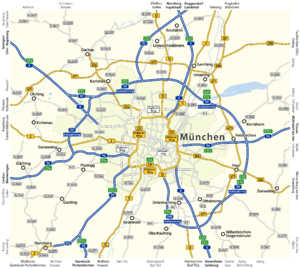
Munich is a key part of Germany's Autobahn (motorway) network. Motorways from cities like Stuttgart, Nuremberg, Frankfurt, and Salzburg end in Munich. This allows direct travel to different parts of Germany, Austria, and Italy.
Traffic in and around Munich can be very heavy, especially during holidays. Munich has an environmental zone, which means vehicles need a special sticker to enter the city and surrounding areas.
Munich International Airport
Franz Josef Strauss International Airport (MUC) is Germany's second-largest airport and one of the largest in Europe. It handles about 46 million passengers each year. The airport is about 30 km (19 miles) northeast of the city center. You can reach it by suburban train, which takes about 40–45 minutes from the main railway station.
Around Munich: Lakes and Nearby Towns
Nearby Towns
The Munich area includes several smaller traditional Bavarian towns and cities. These include Dachau, Freising, Erding, and Starnberg. These towns are part of the Greater Munich Region, which has a population of about 6 million people.
Recreation and Lakes
South of Munich, there are many beautiful freshwater lakes. These include Lake Starnberg, Ammersee, Chiemsee, and Tegernsee. They are popular places for Munich residents to relax, swim, and enjoy water sports. Many of these lakes can be reached quickly by car or by Munich's S-Bahn.
Famous People from Munich
Many notable people, from actors and musicians to scientists and politicians, were born in or lived in Munich.
Born in Munich
- Moritz Bleibtreu (born 1971), actor
- Michael Herbig (born 1968), comedian and filmmaker
- Werner Herzog (born 1942), film director
- Curd Jürgens (1915–1982), actor
- Karl Valentin (1882–1948), comedian and author
- Lou Bega (born 1975), singer-songwriter
- Julia Fischer (born 1983), classical violinist
- Carl Orff (1895–1982), composer
- Richard Strauss (1864–1949), composer
- Lion Feuchtwanger (1884–1958), writer
- Klaus Mann (1906–1949), writer
- Eduard Buchner (1860–1917), Nobel Prize-winning chemist
- Robert Huber (born 1937), Nobel Prize-winning chemist
- Rudolf Mössbauer (1929–2011), Nobel Prize-winning physicist
- Elisabeth of Bavaria (1837–1898), Empress "Sisi" of Austria
- Ludwig II (1845–1886), the "Dream King"
- Franz Beckenbauer (1945–2024), famous footballer
- Philipp Lahm (born 1983), footballer
- Eva Braun (1912–1945), Adolf Hitler's partner
- Abraham Fraenkel (1891–1965), mathematician
Notable Residents
- Pope Benedict XVI (1927–2022), former Archbishop of Munich-Freising
- Albert Einstein (1879–1955), Nobel Prize-winning physicist, grew up in Munich
- Rainer Werner Fassbinder (1945–1982), film director
- Werner Heisenberg (1901–1976), Nobel Prize-winning physicist
- Adolf Hitler (1889–1945), German politician
- Wassily Kandinsky (1866–1944), painter
- Erich Kästner (1899–1974), author
- Vladimir Lenin (1870–1924), Russian revolutionary
- Freddie Mercury (1946–1991), lead singer of Queen
- Hans (1918–1943) and Sophie Scholl (1921–1943), members of the White Rose resistance group
- Giorgio Moroder (born 1940), composer and record producer
- Max Planck (1858–1947), Nobel Prize-winning physicist
- Wilhelm Röntgen (1845–1923), Nobel Prize-winning physicist
- Arnold Schwarzenegger (born 1947), actor and former Governor of California, lived in Munich
- Donna Summer (1948–2012), singer
- Richard Wagner (1813–1883), composer
See also
 In Spanish: Múnich para niños
In Spanish: Múnich para niños


